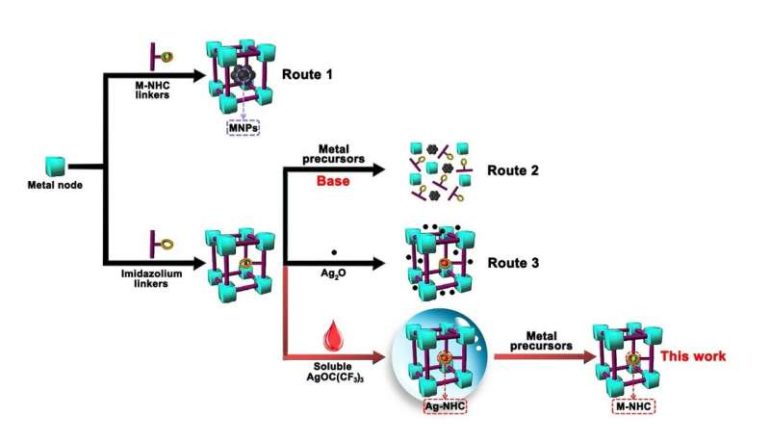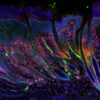This study is led by Dr. Rong Cao (State Key Laboratory of Structural Chemistry, Fujian Institute of Research on the Structure of Matter, Chinese Academy of Sciences) and Dr. Yuan−Biao Huang (State Key Laboratory of Structural Chemistry, Fujian Institute of Research on the Structure of Matter, Chinese Academy of Sciences). Metal N−heterocyclic carbenes (M−NHCs) on the pore walls of a porous metal−organic framework (MOF) can be used as active sites for efficient organic catalysis. Traditional approaches that need strong alkaline reagents or insoluble Ag2O are not suitable for the incorporation of NHCs on the backbones of MOFs because such reagents could destroy their frameworks or result in low reactivity. Accordingly, developing new facile strategies toward functional MOFs with covalently bound M−NHCs for catalysis is highly desirable.
The team found that AgOC(CF3)3 has good solubility in common aprotic solvents such as CH2Cl2, and excellent reactivity with imidazolium moieties to form Ag−NHC complexs. This makes it a perfect candidate for the preparation of M−NHC functionalized MOFs via a transmetalation reaction. As a proof of concept Im−MIL−101, an imidazolium functionalized mesoporous Cr−MOF was selected as a porous support to produce the targeted M−NHC functionalized Im−MIL−101 catalysts, termed M−NHC−MIL−101 (M = Pd, Ir) via a two-step PSM method . Im−MIL−101 was treated with the soluble silver salt AgOC(CF3)3 in CH2Cl2 to generate the Ag−NHC functionalized Im−MIL−101 and this was followed by a transmetalation reaction with a metal salt. Due to the stable mesoporous frameworks with high surface area, the Pd−NHC−MIL−101 and Ir−NHC−MIL−101 bonded single site M−NHCs (M = Pd, Ir) that were obtained can be employed as highly active heterogeneous catalysts which promote Suzuki coupling reactions and hydrogen transfer reactions, respectively. The catalysts could be separated from the reaction mixture by simple centrifugation and can be recycled at least three times without obvious loss of activity. To confirm whether the reactions involved heterogeneous catalysis, a series of control experiments were performed. After the reaction proceeded for 1 h, the catalyst Pd−NHC−MIL−101 or Ir−NHC−MIL−101 was removed from the hot reaction mixture, and the isolated solution did not exhibit any further reactivity under the same reaction conditions. Moreover, after the reactions were complete, the ICP−AES analysis revealed that almost no Pd or Ir leached out into the isolated solution, which attests to the excellent stability of the covalently bound M−NHC catalyst.
In summary, the researchers developed a facile and general approach to the preparation of functionalized MOF catalysts with a covalently anchored and well−defined metal−N− heterocyclic carbene single site by using a soluble AgOC(CF3)3 source and a subsequent transmetalation reaction. This unique strategy could efficiently avoid the formation of MNPs and destruction of the framework structure of MOFs during the preparation process. This facile synthesis strategy is widely applicable to the preparation of other porous materials such as covalent organic frameworks, metal organic cages and porous organic polymers with covalently bound M−NHC single sites for highly efficient catalysis.
Metal organic frameworks’ metallic mastery
More information:
Chang He et al, Metal-Organic Frameworks Bonded with Metal N-Heterocyclic Carbenes for efficient catalysis, National Science Review (2021). DOI: 10.1093/nsr/nwab157
Provided by
Science China Press
Citation:
Metal-organic frameworks with covalently bound metal N-heterocyclic carbenes for catalysis (2021, October 22)
retrieved 25 October 2021
from https://phys.org/news/2021-10-metal-organic-frameworks-covalently-bound-metal.html
This document is subject to copyright. Apart from any fair dealing for the purpose of private study or research, no
part may be reproduced without the written permission. The content is provided for information purposes only.



